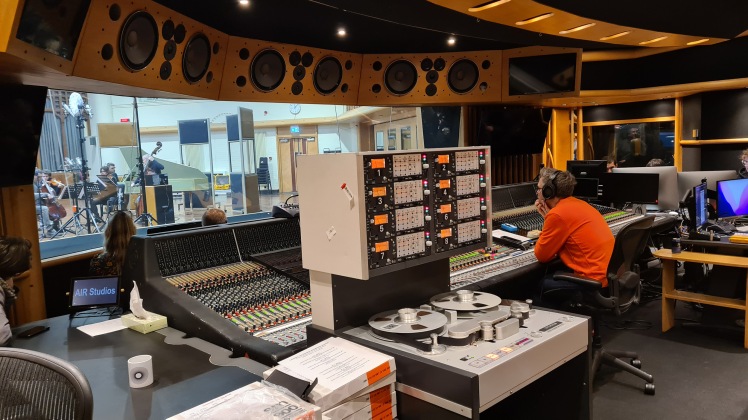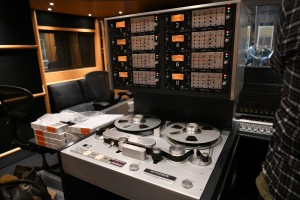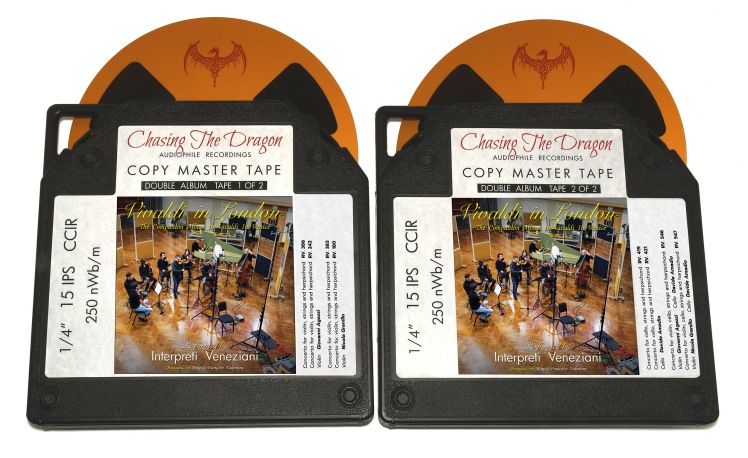
UK-based label Chasing The Dragon’s ‘Vivaldi in London’ album is a two-tape set of eight Vivaldi concertos, and is a companion double album to their earlier ‘Vivaldi in Venice’ album. Like ‘Vivaldi in Venice’, ‘Vivaldi in London’ is performed by the internationally famous Interpreti Veneziani baroque orchestra.
When ‘Vivaldi in Venice’ was released (in 2019), hi-fi journalist Neville Roberts attended the recording and wrote about his experiences in a guest blog here, which I then followed up with a review of the tape.

So we thought we’d do the same thing now for ‘Vivaldi in London’. Neville kicks off below with a brief report from the recording session, followed by his impressions on listening afterwards to the finished tape. I then add my thoughts about the tape, plus I’ve added a video chat which includes an interview with Chasing the Dragon’s Mike Valentine exploring his take on audiophile recording.
Before we kick off, it’s worth mentioning that Mike feels that ‘Vivaldi in London’ is Chasing the Dragon’s finest recording yet, and The Absolute Sound’s Robert Harley has described it as “the finest recording of a chamber orchestra I have ever heard!”. So expectations were running high…
Neville Roberts reports from London’s AIR Studios

It was a sunny December morning when I arrived at AIR Studios in London, filled with anticipation. Some final adjustments were being made to the microphone positions and Interpreti Veneziani were rehearsing some of the music.
The album was to be recorded ‘direct to disk’ for a double LP release, as well as being simultaneously captured on tape. For the latter, the eight microphones were hooked up to Chasing The Dragon’s newly-acquired 8-track Studer A80 tape recorder, ready for recording at 15 ips on 1-inch tape. All eight microphones were valve mics fitted with high-quality specialist valves. The mic line-up included the Flea 12 (AKG C12), the ELAM 251 and the Neumann U67. Audiophile-quality cabling rather than normal studio-quality cabling was used for connecting up the microphones, preamps, mixers and recorders. Similarly, the A80 had been fully restored using entirely audiophile-quality components in the audio chains.
The demands on musicians making a direct-cut LP album are considerable, as mistakes can’t be edited out afterwards. As a result, the performance has all the immediacy (and no doubt much of the nerves!) of a live performance. Over the years, I’ve accumulated a large collection of Vivaldi’s music as he’s one of my favourite composers and his music always raises my spirits. On this day, all the musicians were clearly performing at the top of their game, and in terms of the Vivaldi concertos that I’m familiar with, they produced some of the finest renditions I’ve heard.
The resultant recording was mixed to stereo at a later date in order to produce a ½-inch stereo master on a Studer A820 recorder. It is this stereo master which is then used to make the copy-masters (the ones that you buy) to order on Recording the Masters LPR90 high output premium quality tapes.

Neville heads home with the recording
Having now listened to the stereo tapes, I can confirm that they produce a sound that’s as close to the live performance as you’re likely to experience (and you can trust me on that, since I was there!). In fact, the music is breathtakingly real in my listening room and right from the first concerto on Tape 1 – RV386 for violin, strings and harpsichord – I find myself transported back to the main hall at AIR Studios. The rest of this tape contains three other concertos for violin, strings and harpsichord (RV242, RV383 and RV180). Tape 2 features the wonderful playing of cellist Davide Amadio and opens with two concertos for cello, strings and harpsichord (RV419 and RV421).
This second tape concludes with two concertos for violin, cello, strings and harpsichord (RV546 and RV547). As well as the cello playing of Davide Amadio, the violin playing on each of these eight concertos, performed by either Giovanni Agazzi or Nicola Granillo, is simply superb. If you want to hear a sample of the actual recording, Mike Valentine of Chasing The Dragon has published a short video taken from the Control Room on YouTube which you can view here:
Over to Dave Denyer’s listening room
Out of all of Chasing the Dragon’s superb audiophile recordings that I own, some have had much more play in my system than others – which isn’t a reflection on their relative ‘audiophile’ merits, more a reflection of my personal preferences – for the music, the performer(s), the recording set-up and the sonic signature of the venue.
For all of these reasons, my most-played Chasing the Dragon title is the utterly sublime ‘Vivaldi in Venice’. Vivaldi’s music has a soothing lightness that relaxes, and an energising, uplifting joy that I often find myself reaching for on a sunny Sunday morning, for example. (Actually, that also goes for other examples of baroque chamber music: lately I’ve been finding myself drawn to Hayden and Corelli too.) The performers here – the Interpreti Veneziani – are truly brilliant and are another key reason why this is such a go-to recording for me. But what also elevates this album is the sense of the space, the ambiance, the feeling of being transported into a staggeringly beautiful Venetian church. The recording captures all of the essence of the exquisite venue: San Vidal, in the Campo Santo Stefano, Venice.
So I’m curious about what I’ll make of ‘Vivaldi in London’. It has Vivaldi, obviously. It has Interpreti Veneziani. But in place of that Venetian church we now have London’s AIR Studios. Of course we still have Mike Valentine’s first-class recording technologies and processes, but they too are changed here, since Mike of course adapts his decisions and processes in order to perfectly match the situation and conditions at hand.

It’s also interesting to note that this is the first recording that Chasing The Dragon have made since acquiring their superb ‘new’ Studer A80 1-inch, 8-track recorder. I got wind of this development a while back, as Mike Valentine and I both use the tape tech services of Petronel Butuc at The Audiophles Clinic and we’ve been discussing our Studer A80s since we bought them, both around a similar time. Mine of course is a 2-track machine whereas Mike’s is an 8-track, but I’m really keen to hear what Mike can achieve now that he has analogue multi-track capabilities in his arsenal!

Until now, Mike has always recorded in stereo, requiring the mix-down to be done ‘live’ so to speak. Sometimes the mixing desk might be 32 or more channels, such as those at AIR Studios, while at other times it might be just 4 channels mixed down to 2, such as on the aforementioned ‘Vivaldi in Venice’. Either way, the fact that mixing has to be done live, in the moment, inevitably limits to some degree the producer’s absolute ‘composition’ of the sound. Sure, some touching up can be made in mastering but ultimately, what’s recorded to 2-track can’t be unpicked (at least not without resorting to the heinous AI solutions being pioneered on the ‘new’ Beatles releases and the like, but let’s not go there!).
Anyway, the ability for Mike to now record in multi-track allows him to revisit the multi-track and each individual microphone feed, and then to mix them into a potentially more finished and balanced final result. What will that give, I wonder…? And how will it compare with the infamous ‘Vivaldi in Venice’?

These are the thoughts jostling around in my over-active brain as I load up the first tape, and press play…
Boom. From the first note, something is obvious. This recording exhibits staggering presence and clarity. OK, so you don’t get the voluminous sound of the beautiful church in Venice, but what you do get is more a measured, more evenly balanced, solid, natural weight, air and flow.
I can still hear the air in the room, but whereas some audiophile recordings can sound somewhat unbalanced – either too shrill, or too fat – AIR’s Studio number one is stunningly captured here. I’ve been there: it’s a large, superb sounding studio (and it is in fact thanks to Coldplay that Mike was able to use this room in this instance, due to a booking conflict, but that’s another story…!).

As for the music, the Vivaldi is more visceral here. The instruments feel more solid, weightier, more balanced and more rooted in space than in the airy ambiance of the Venice recording. The presence and purity of the sound is something else, something extremely rare. Just prior to listening to ‘Vivaldi in London’ I’d been listening to Analogue Productions’ UHQR vinyl release of Steely Dan’s Gaucho (there’s a video of me rambling about that over on YouTube at www.youtube.com/watch?v=96lODl9tjTE). Now, this is perhaps one of the best sounding vinyl records ever made, it’s truly superlative, but if you want to know how tape compares to vinyl (ie. good, master-quality tape): this tape makes the Gaucho UHQR feel contrived, constricted, vague and just a bit lacking (which it isn’t, at all, I’m talking purely comparatively).
In conclusion, I’ll go even further than Robert Harley and say that ‘Vivaldi in London’ is one of the best sounding master copy tapes I’ve heard, period.
If you’re in the market, the ‘Vivaldi in London’ tapes are made to order and can be purchased directly via the Chasing The Dragon website at www.chasingthedragon.co.uk/copymastertapes.html. The price is £700 for the double ¼” 15ips copy-master tapes.
Want to hear more about it? There’s a bit more of my rambling on video here (covering the direct to disk recording as well as the tape) along with an interview with Chasing the Dragon’s Mike Valentine.
Direct-to-disk and other formats
By way of a P.S.: In addition to those microphone feeds going direct to the multi-track Studer A80, they were also ‘mixed live’ to stereo and fed to AIR’s cutting room where direct-to-disk live-cut lacquers were made. As Neville alluded to above, this is an important factor affecting all versions of this recording. Because this was being cut to lacquer it meant that each ‘side’ of the resulting LP had to be performed / recorded and cut in one take – which literally required that the performers play ‘live’ with no going back and correcting for mistakes, no overdubs, no added anything. The resulting life, authenticity and immediacy is therefore reflected in the tape edition, and clearly also the CD and 24/196 digital downloads also available.
‘Vivaldi in London’ is available in four versions:
- Double ‘direct-cut’ vinyl LP
- Double reel-to-reel master copy tape
- Double CD
- 24/192 download.
You’ll find everything you need to know, including ordering information, at www.chasingthedragon.co.uk



